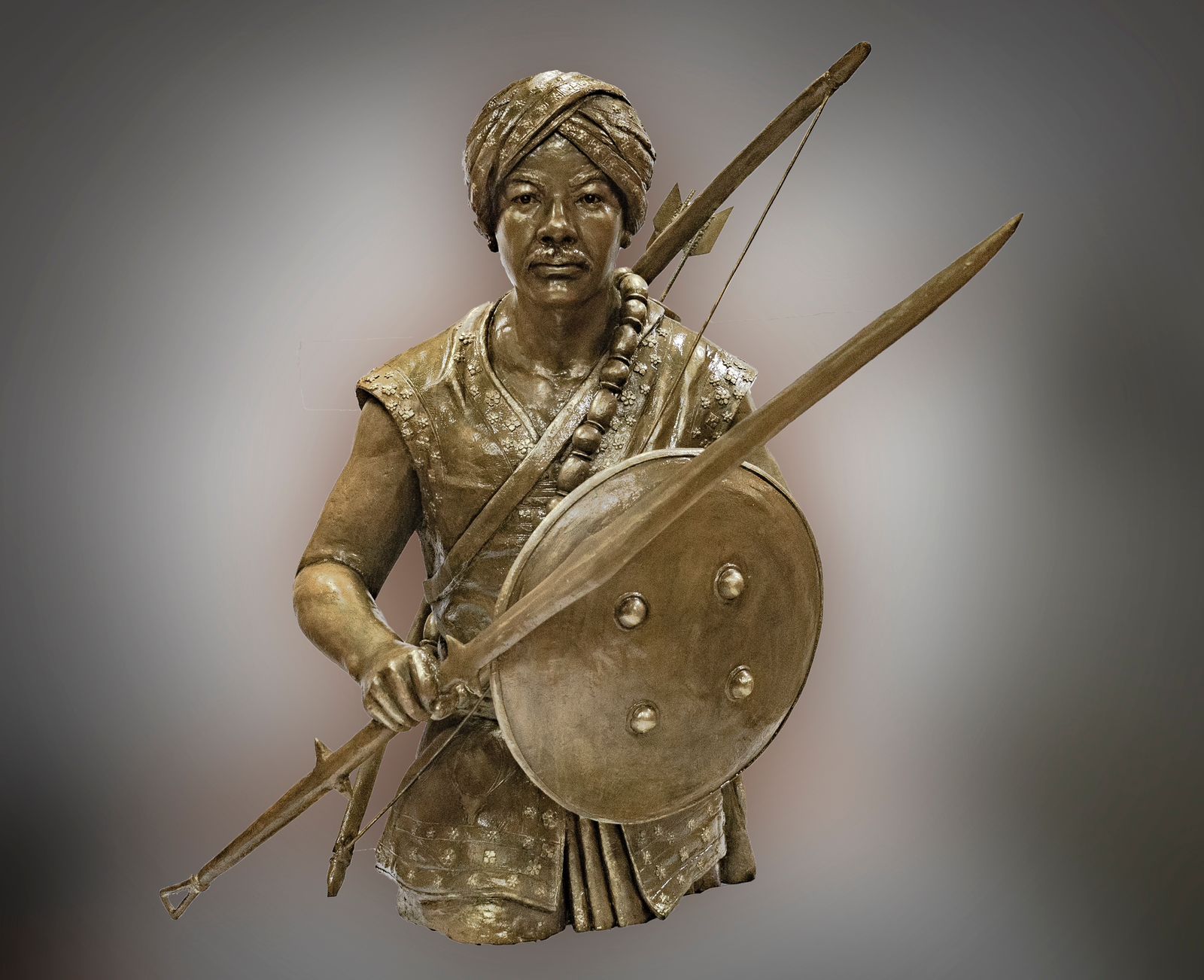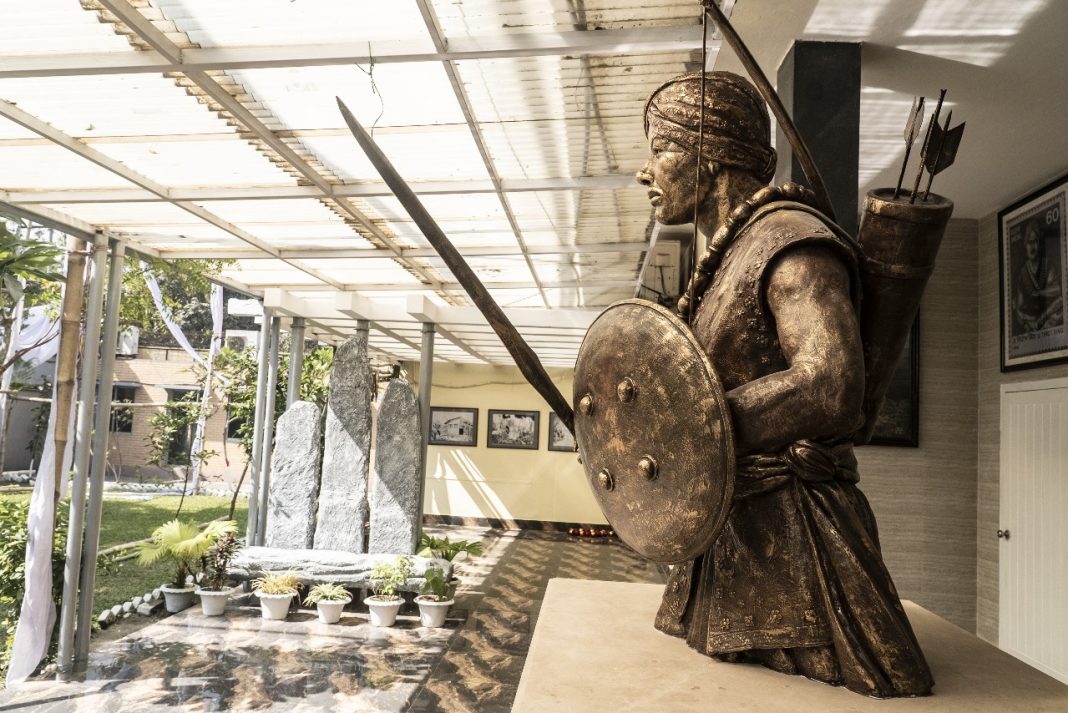-Raphael Warjri
There was a time when the authorities initiated the application for a commemorative stamp of Tirot Sing Syiem in the Postal Department of the Union Government. It may be stated without doubt that the portrait picture of Tirot Sing Syiem is definitely required and there was no source to derive any authentic picture of the freedom fighter. There were attempts to acquire a proper image of the freedom fighter and the two most preferred local artists emerged at that time, Bashai Rai Dohling and Marius Main Sing Shanpru. Bashai Rai Dohling was an animation artist of the Directorate of Film Division, Ministry of Information and Broadcasting, Government of India at Bombay, while Mainsing Shanspru was an artist in the Directorate of Information and Public Relations, Government of Meghalaya. While both of them were preparing a portrait of Tirot Sing Syiem, I was told that Bashai Rai Dohling was engaged on a certain vital assignment at the Film Division and, under compulsion, entrusted the assignment to his junior artist at Bombay. In the absence of a proper image and the urgency of the matter, there was a deviation from the local essence of depiction, because the junior artist was from mainland India.

Fortunately, at a time I (Raphael Warjri) was engaged as an apprentice of Bah Main Sing Shanpru from the year 1980 onwards. Therefore, I had witnessed an imaginary portrait of Tirot Sing Syiem painted by my mentor, Mr Marius Main Sing Shanpru . Although I was a novice at that point in time, but little that I knew about history, I threw a piece of my mind to my mentor, saying “Tirot Sing Syiem died a young man, but the portrait seems like an old man”, I suggested that it needed to be rectified. However, due to the urgency of the matter, Bah Main Sing was compelled to submit as it was and selected for publication of the stamp, which came out into the public domain and the rest is history. I was not content and took upon myself to argue about the authenticity of Tirot Sing Syiem’s feature. It so happened that, simultaneously pursuing art, I was also an ardent amateur photographer. Hence, I learnt that photography was invented in the year 1839 and that it was also nascent in Europe, but Tirot Sing died in the year 1835. Furthermore, photography was introduced in India in 1855, while Khasi territory was situated in the remotest part of the country without an iota of any exposure to the new vista.
Further, it was also assumed that the British authorities would not have bothered with assigning any pictorial sketch or illustration of Tirot Sing Syiem, a Khasi chieftain, who was a subjugated political prisoner till his demise on 17th July, 1835. In the quest for an authentic picture of Tirot Sing Syiem, I was driven towards the media during the 1990s and met renowned personalities: Skendrowell Syiemlieh, a folk music legend, and Kitdor Syiem, a prominent politician and Minister. In the course of my discussion with Skendrowell Syiemlieh, he introduced me to the reigning Syiem Phrestar Syiemlieh, who still is the Syiem of Hima Nongkhlaw at present. We have made a proposal to make a historical documentary film on the Khasi freedom struggle against British colonial rule, where Tirot Sing Syiem was a pivotal figure. However, it didn’t work in spite of commitment from Dorbar Hima Nongkhlaw and Kitdor Syiem. Meanwhile, Dr David R Syiemlieh discovered the actual date of the demise of Tirot Sing Syiem in 1988 and, subsequently, pursued him regarding the actual facial features of Tirot Sing Syiem, but to no avail that even the record on the disposal of his mortal remains was not available till today.
Thereafter, we had a discussion with one of the nobles of Hima Nongkhlaw, Boldness Lyngdoh Nongum, a former minister and educationist. The memorial heritage monument was proposed at Mairang with a detailed artistic plan and estimated expenditure to be presented to the Dorbar Hima Nongkhlaw. In this regard, we have conducted a site inspection and the architectural and aesthetic presentation to the Syiem and the Dorbar Hima. Everything was going well until it was intervened by a local influential person with an ulterior motive. Unfortunately, the project was instead awarded to a contractor who devastated the entire project and made a frivolous structural construction incorporated with a ready-made and improper statue of Tirot Sing Syiem at Mairang.
After the completion of the commemorative arch gate and relief sculpture mural at State Central Library commissioned by the Government of Meghalaya, Mr F R Kharkongor, Commissioner and Secretary, Arts and Culture, sought a proposal for the sculpture project of the three freedom fighters of the State as desired by the then Minister, Mr Sanbor Shullai. The same was presented, approved and executed with meticulous research and artistic representation of the freedom fighters. Although, there were time constraints to comply with the ongoing celebration of Azaadi Ki Amrit Mahotsav, the larger than-life statues were completed as desired by the authorities.

It is pertinent to elaborate on the method of research and actual execution of the sculptural project of the freedom fighters of the State. With regards to Tirot Sing Syiem, as mentioned, there were earlier inputs from Bah Skendrowell Syiemlieh, Kitdor Syiem and the present Syiem Phrestar Syiemlieh, including further findings from the family lineage of Raja Kine Sing Syiem and Kedro Manik Syiem. Therefore, a fictional image was innovated from the features of the royal clan justified by biological, and genetic hereditary for the closest identity. Moreover, the careful attention to the royal attire of a chief and warrior, including the physical structure, was properly investigated and depicted in the sculpture. Some of the significant features are a decorative turban or ‘Spong Khor’ in Khasi, intricate designs on the upper garment or Jymphong Syiem and on the lower wrap-over garment or ‘Boh Khaila’, an ornamental coral and golden pendant, or ‘Paila Ksiar’ worn across the shoulder to the waist and not like a necklace, a wrist band as protective gear for archers, a sword, shield, bow, quiver with arrows in the Khasi traditional design and more importantly bare hand and bare footed.
An artistic portraiture of the Khasi essence of freedom struggle is presented as a warrior in action for the defense of the citizens and the homeland. The eyes are focused on the target and the body language is well-composed, gentle with confidence and stability, including a firm grip of the sword and the shield. This is contrary to the conventional depiction of the offensive and aggressive posture of a tribal militant fighting with wrath and vengeance or the posed and stiff image of a conceited monarch and soldier. In a similar manner, the process was also conducted for Kiang Nangbah and it was discovered that the descendants of Kiang Nangbah wandered and fled away from Jowai under the intimidation of the British colonial rulers. There was no trace of the Nangbah clan at the ancestral home of Kiang Nangbah at Wah Nangbah, Tpeppale since then and, ultimately, there were oral narratives about the Nangbah families from Jaraiñ and Lamin villages. In pursuance of the matter, there was hardly any knowledge at Jaraiñ, except for the family members of a prominent citizen of Shillong, Barnabas Nangbah, who hailed from Lamin village. Hence, a feature study was conducted on the family members of Barnabas Nangbah and the portrait of Kiang Nangbah was constructed and the sculpture was carved, while the rest of the attire was investigated and incorporated accordingly. As regards Pa Togan Nengminza Sangma, there is hardly any knowledge, except for a few inputs from a young artist, Arak Sangma and Ms. Sahana Marak, a Garo cultural exponent and former senior officer of the Arts and Culture Department. One relevant insight into the portraiture of the physical structure of the local freedom fighters is to avoid any exaggerated depiction of the six-packed muscles of modern bodybuilders. Therefore, the physical structure of local freedom fighters is constructed in the manner of an actual encounter with nature in the ambiance of domestic activities, agricultural and jungle experience of the related period.
Regarding the statue of Tirot Sing Syiem, the past inputs were taken into consideration, and consultation is still carried on with every resourceful person, particularly an academic authority on Tirot Sing Syiem, Dr David R Syiemlieh, and care has been taken to maintain the same feature in all the statues that have been sculpted at State Central Library, the bust statue initially meant for Dhaka, the waist length statue at Raj Bhavan, Shillong and, finally, the waist-length statue at Indira Gandhi Cultural Centre, Indian High Commission, Dhanmundi, Dhaka, Bangladesh. Therefore, the earlier depiction by different artists under various circumstances, which was random imagination and does not comply with acceptable norms, is requested for appropriate action by the concerned authorities. It may be noted that since the past few years, Mr F R Kharkongor has spearheaded and communicated with the Indian High Commission for the construction of a comprehensive heritage memorial on Tirot Sing Syiem in Dhaka. The heritage site consists of relief sculpture murals depicting significant historical events of the Freedom movement, a large-format replica of the commemorative stamp of Tirot Sing Syiem, an old British Map of the Khasi States, including Hima Nongkhlaw, a display of pictures on the sequence of historical narratives of the encounter between Tirot Sing Syiem and Dorbar Hima Nongkhlaw with the British colonial regime, which led to the outbreak of the Anglo-Khasi war till the attainment of martyrdom of Tirot Sing Syiem.
Furthermore, Mr Paul Lyngdoh, Minister of Arts and Culture, initiated an official visit to the then Dacca Central Jail, where Tirot Sing Syiem was kept in custody. During an official visit to the old Dhaka Central Jail, there was discussion with the jail authorities about the setting up of another memorial in the name of Tirot Sing Syiem, in the presence of the minister and other cabinet colleagues and other dignitaries. The discussion was accompanied by Mr Sniawbhalang Dhar, Deputy Chief Minister, Dr Ampareen Lyngdoh, Minister of Information and Public Relations, and Paul Lyngdoh, Minister of Arts and Culture, and participated by Dr David R Syiemlieh, Mr F R Kharkongor in the presence of Metbah Lyngdoh, Titos Starwell Chyne, Hamlet Dohling and Teibor Pathaw. The proposal is being prepared by the state government to expedite the matter.
Read: State Women Commission seeks Assam-Meghalaya coordination to catch perpetrators
WATCH:
Find latest news from every corner of Northeast India at hubnetwork.in, your online source for breaking news, video coverage.
Also, Follow us on-
Twitter-twitter.com/nemediahub
Youtube channel- www.youtube.com/@NortheastMediaHub2020
Instagram- www.instagram.com/nemediahub



